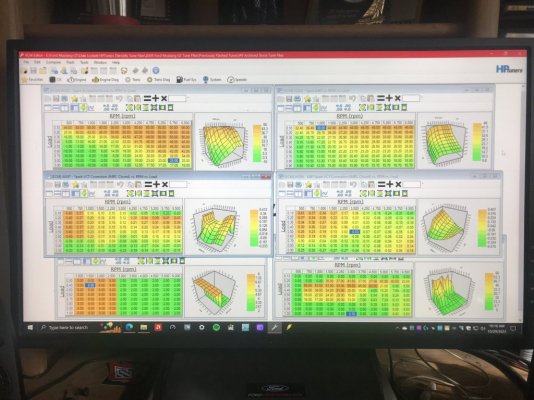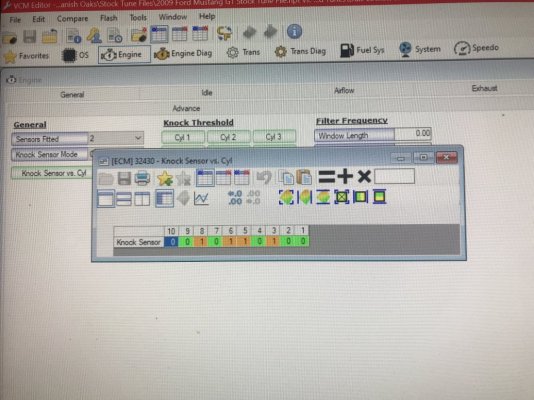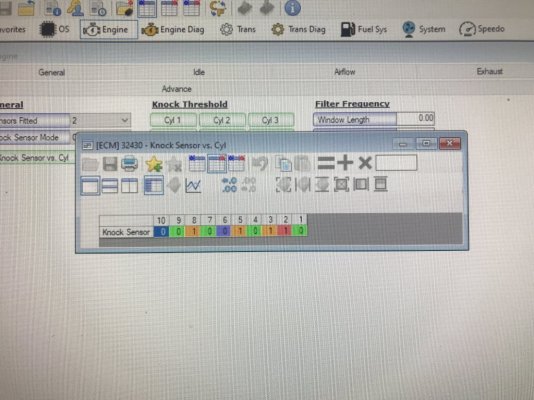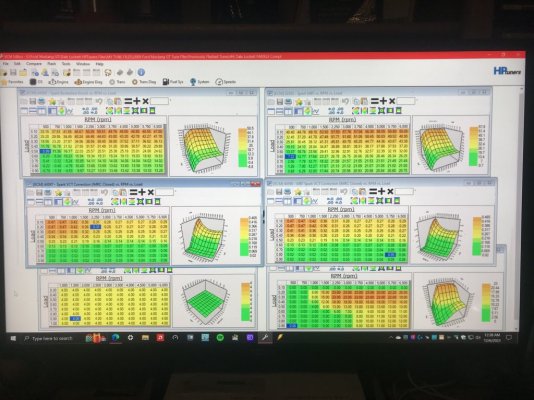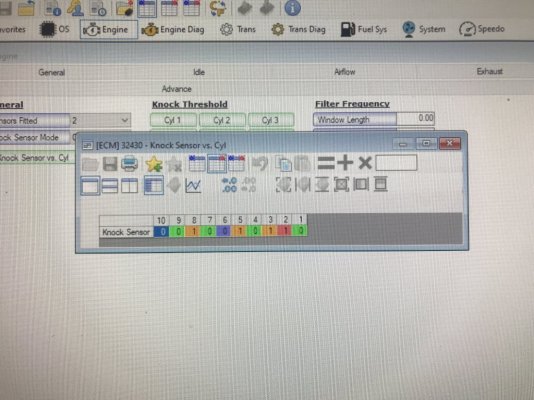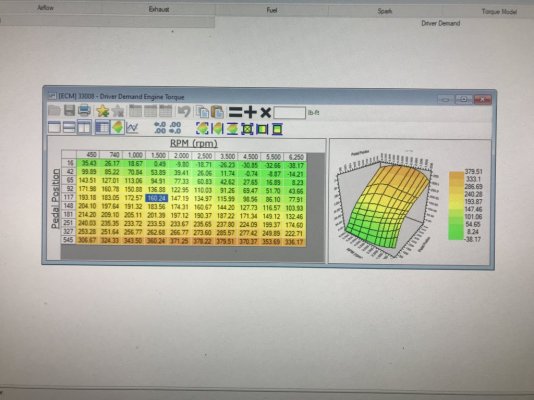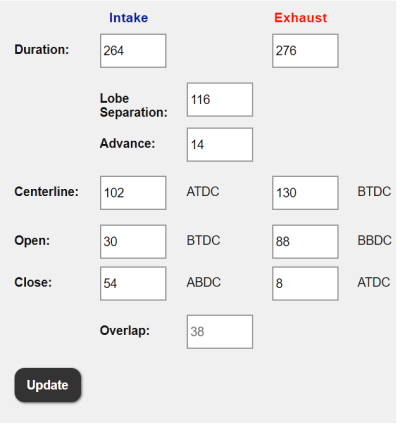FYI....................
Just got back last night from being OOT on family business & I drove my Stang home & back........so approx 2,000+ mi over a 6,000'+ elevation drop\rise from essentially "desert" to "lush" landscape (oxygen limited to oxygen rich) & I've observed a few things concerning tuning these engines using the OEM SO ECU..............
1st, you need to take into account the topology of where you're doing the tuning to then make some allowances of any potential changes--whether mechanical or computer programming--that may be encountered that will affect how the ECU's TM will control the engine. So, I now better understand how engine "bucking" is created......yes, cam profile is an influencer, but the overarching thing is how the engine is set up to be used thru TM during\around engine idle speeds. Up here in the US 4 Corners area where there is very little "flat & level" geography, my tuning is reflecting this......up here, after making all the changes\repairs tuning-wise along w\ my 3.91 gear ratio\26" dia tires (setting a mean net ratio of 4.02:1) my engine doesn't hardly buck at all, even using the heavy 1st trans gear 3.38:1 ratio taking off & creeping around........but when I was down in the Longview, TX (essentially E. TX) area w\ my engine breathing in all that oxygen rich air & the topography being nowhere near as in the US 4 Corners area, using 1st gear was essentially a hot mess some of the time as the engine was so unloaded thru the mechanical gearing for the surrounding topography & at the same time was so "excessively TQ requested" thru the TM DD TQ Request 750 RPM column\16 A\D count row idle TQ of 26.14 ft-lbs using my Lunati VooDoo #21270700 cam timing profile so either way, during idle, the engine tended to want to buck around quite a bit in 1st gear from TM trying to constantly chase between this trying to control the engine once the clutch was engaged, I quickly realized that while down there, I needed to use 1st gear to only start the car to move then quickly shift into 2nd gear to put enough mechanical loading on engine so TM can now calm down & smoothly calc idle TQ output from the existing TM DD TQ Request to control the engine. This got real bad during my trip home going thru the DFW area during morning rush hour traffic.......raining on top of it as well......along w\ all the road work also going on.......so had to do a LOT of idle creeping from slow moving traffic.......until I started shifting into 2nd gear as soon as car started moving in 1st gear as I had plenty of idle TQ requested for TM to use to maintain the engine idle speed of 740 RPM's w\o having to fluctuate the TB hardly at all (where the bucking is coming from) thus maintain good tight airmass flow control into engine so ECU is mainly using secondary idle spark alone to control engine idle speeds then ride 2nd gear as long as I could before being forced to downshift into 1st gear to stay away from the bucking.
It ain't so much the cams themselves--even though their cam timing profile can influence this...........it's how well all the front-end tuning is setup\matched to the mechanical components under ECU TM to operate under the associated environments expected to encounter while under the ECU's adaptive idle speed control algorithm........IOW's a balance has to be maintained.
Good part is that all of this is an easy fix w\o having to change anything mechanically...........once you understand how\why it's happening. So, another item is also true w\ this engine\ECU combo.......
there is no such thing as low end TQ loss under the curve w\ any camshafts used in this setup......IF you
actually reconfigure VCT & TM to "fit" the camshaft's cam timing profile to gain the necessary TQ leveraging.
Heck in my case.......under certain conditions.......I've clearly overdid this & my engine is producing
too much idle\low speed TQ off TM operations......w\ a set of aftermarket non-OEM cams.........using CMDPs!
IMHO, the TQ losses are seen simply due to tuners trying to keep using the same OEM VCT cam timing\TM OEM 16 A\D count row\740 RPM column idle TQ request along w\ the same fuel inj EOIT CA ref setting Ford set up to use w\ the OEM stock cams timing profile......w\ a different cam timing profile. I have 2 examples in hand of a couple of tuner's tune calibration files--besides my prior tuner--that I got off HPTuners BBS Ford tuning forums that show this in spades using these very same FRPP Hot Rod cams......both tuners also were looking for help at the time as the expected HP\TQ outputs they were getting from these Hot Rod cams were not meeting their expectations........
You can learn from other's mistakes..........if you just learn to look, listen then
do the legwork to either verify or disprove what is stated & not just take at face value what other folks say........regardless of how long they've been doing it or how "experienced" they say they are.
This goes for myself included..........
So, going forward, I'll definitely be adding into my tuning routines to find some flat areas to use to "tune" for this as well to try to cover both ends so car will be manageable regardless of where I'm driving it as I KNOW these FRPP Hot Rod cams timing profile is gonna be needing this type of attention to help them operate well under TM in both steep & shallow topographies.
Also, this trip has now worked the ECU enough to get a true sense of how all is stacking up for both MPG & emissions.........the results are again very stellar. Going down, my MPG started at 19.1 MPG but halfway thru the trip (roughly 500 mi & 5,000' elevations drop after the 1st fill up w\ E10 93 oct fuel in Amarillo, TX.... used this fuel the rest of the way) hit 22.6 MPG & settled down here the rest of the way in. Checked the Cat CE Ratio at the hotel in Longview, TX as follows...B1 @ .117, B2 @ .121....started on trip at B1 @ .141, B2 @ .156 off last check so emissions got better in more dense warmer air, not worse......speaks highly of engine's operating efficiency thru the tuning. On the way back home, she started out on E10 93 oct fuel at 22.4 MPG, quickly moving back to 22.6 MPG within 50 mi then settled in here.....until I filled up in Claude, TX at a Valero station that had E10 91 oct fuel (which from here on out was the fuel used....again approx halfway), after this the MPG started to slowly climb from 22.6 MPG to 23.3 MPG when I backed into my driveway last night (this was purely due to engine coming back under the conditions it was originally tuned under.....mostly increasing elevation & lowering IAT......specifically what MAF Adaption is actually making fueling corrections from airmass density corrections--if left enabled in tune calibration--using the MAF sensor density\IAT readouts to correct the hard coded LWFM airmass map calcs under Ford's vers of SD......just as it did when going down in elevation along w\ warming IAT) thus the modeling is spot on accurate. Checked the Cat CE Ratio readouts today as follows......B1 @ .102, B2 @ .094......so emissions got even better on the return trip home......all this is coming thru them Motive Gear 3.91 gears running 26.1" dia Conti Extreme Contact DWS06 tires at a mean effective ratio of 4.02:1 ..........w\ a 4.6L SBE NA 3V engine in good operating condition w\ 170,693 mi now on the clock.
But I did have 1 snafu...........found my rt front marker light\turn signal yellow housing's inner mount tab had come out of its bumper mounting hook & was flopping off the rear mounts & wiring harnesses.........nothing hit the front of the car at all during the entirety of the trip. Checked the bumper & found that the bumper hoop that the marker housing's mounting tab went into had broken off on 1 side........so NOW I need a new front bumper......but I'm gonna give it a good shot at fixing it by using some JB Weld to see if this will hold it or not before going there, since checking on CJ Pony Parts site a new GT std front bumper cover unpainted is running for $641.95 + tax.
The money isn't the issue.........the issue is this current front bumper isn't Ford OEM part & is most likely the reason why I'm in the situation I'm in now (PO used an aftermarket non-Ford OEM front bumper cover for repairs to an accident(s) that wasn't reported to insurance......VIN came back clean when I ran it prior purchase back in 10-2017 but when doing other work on car after purchase, the evidence I ran into said otherwise).
Genuine Ford OEM body components for these 05-09 S197s are getting harder & harder to find\locate.......as I'm positive that if this part was a genuine Ford OEM part, I wouldn't be talking\complaining bout this right now...........
Otherwise, all was fantastic w\ the Stang!
She put the "C" in cruiser & all the Dynamat\Dynaliner sound deadener installed showed its weight in gold!
Gonna be a little hard for me to pull these Lunati's out............but the FRPP Hot Rod chop has spoken & I can't resist it anymore!
PS--Damn 3V's & their firing order..............................





